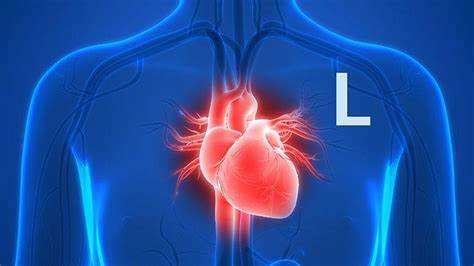Left-sided heart failure is a common and serious condition where the left ventricle of the heart is unable to pump blood efficiently. This inefficiency leads to a range of physiological issues and symptomatic manifestations. One critical aspect of left-sided heart failure is the backup of blood, which affects various parts of the circulatory system. To understand where blood backs up in left-sided heart failure, it is essential to delve into the mechanisms of the heart, the consequences of its impaired function, and the clinical implications of this condition.
Mechanism of Left-Sided Heart Failure
The heart comprises four chambers: two atria and two ventricles. The left ventricle, which is the heart’s primary pumping chamber, is responsible for pumping oxygen-rich blood from the lungs into the systemic circulation to supply the body’s tissues. In left-sided heart failure, the left ventricle either becomes too weak to pump effectively or becomes stiff and unable to fill properly. These conditions are typically categorized as systolic heart failure (reduced ejection fraction) and diastolic heart failure (preserved ejection fraction), respectively.
SEE ALSO: How Long Can You Live with LV Dysfunction
Causes of Left-Sided Heart Failure
Several factors contribute to the development of left-sided heart failure, including:
Coronary Artery Disease (CAD): Blockages in the coronary arteries reduce blood flow to the heart muscle, leading to weakened cardiac function.
Hypertension: Chronic high blood pressure forces the heart to work harder, causing the left ventricle to enlarge and weaken over time.
Cardiomyopathy: Diseases of the heart muscle can lead to decreased efficiency in pumping.
Valvular Heart Disease: Malfunctioning heart valves can lead to increased workload on the left ventricle.
Myocardial Infarction: Heart attacks can damage the heart muscle, leading to reduced pumping capacity.
Pathophysiology of Blood Backup in Left-Sided Heart Failure
In left-sided heart failure, the heart’s inability to pump effectively causes a cascade of physiological events:
Increased Left Ventricular End-Diastolic Pressure (LVEDP): As the left ventricle fails to pump adequately, blood accumulates, increasing the pressure within the ventricle.
Increased Left Atrial Pressure: The elevated pressure in the left ventricle is transmitted backward to the left atrium, causing it to also experience increased pressure.
Pulmonary Congestion and Edema: The elevated pressure in the left atrium is then transmitted to the pulmonary veins and capillaries. This increased pressure forces fluid out of the capillaries into the lung interstitium and alveoli, leading to pulmonary congestion and edema.
Clinical Manifestations of Blood Backup
The backup of blood in left-sided heart failure manifests through various symptoms and clinical signs:
Dyspnea: Shortness of breath, especially during exertion or while lying down (orthopnea), is a hallmark symptom due to pulmonary congestion.
Paroxysmal Nocturnal Dyspnea (PND): Sudden episodes of severe shortness of breath at night due to fluid redistribution while lying down.
Cough: A persistent cough, often producing frothy or blood-tinged sputum, may occur due to fluid accumulation in the lungs.
Crackles/Rales: On auscultation, crackling sounds in the lungs indicate the presence of fluid in the alveoli.
Reduced Exercise Tolerance: Fatigue and weakness due to insufficient oxygen delivery to tissues.
Cyanosis: Bluish discoloration of the lips and extremities due to poor oxygenation.
Systemic Effects of Pulmonary Congestion
The consequences of blood backup extend beyond the pulmonary system and affect overall systemic function:
Hypoxemia: Reduced oxygen levels in the blood due to impaired gas exchange in the fluid-filled alveoli.
Right-Sided Heart Failure: Chronic pulmonary congestion increases the workload on the right ventricle, leading to its eventual failure (cor pulmonale).
Renal Impairment: Reduced cardiac output and poor perfusion can lead to decreased kidney function and fluid retention, exacerbating heart failure.
Cognitive Impairment: Poor cerebral perfusion can lead to confusion, dizziness, and cognitive decline.
Diagnostic Evaluation
Diagnosing left-sided heart failure involves a combination of clinical assessment, imaging, and laboratory tests:
Clinical Examination: Assessing symptoms, physical signs (e.g., lung sounds), and medical history.
Echocardiography: An ultrasound of the heart to evaluate ventricular function, wall motion abnormalities, and valvular conditions.
Chest X-ray: Identifying pulmonary congestion and cardiomegaly (enlarged heart).
B-type Natriuretic Peptide (BNP): Elevated levels of BNP or NT-proBNP are indicative of heart failure.
Electrocardiogram (ECG): Identifying ischemic changes, arrhythmias, and left ventricular hypertrophy.
Management And Treatment
Managing left-sided heart failure involves a multifaceted approach aimed at reducing symptoms, improving cardiac function, and preventing disease progression:
Medications:
Diuretics: Reduce fluid overload and pulmonary congestion.
ACE Inhibitors/ARBs: Lower blood pressure and reduce ventricular remodeling.
Beta-Blockers: Decrease heart rate and improve ventricular filling.
Aldosterone Antagonists: Reduce fluid retention and fibrosis.
Inotropes: Improve contractility in severe cases.
Lifestyle Modifications:
Dietary Changes: Low-sodium diet to reduce fluid retention.
Exercise: Tailored exercise programs to improve cardiovascular fitness.
Smoking Cessation: Reduces cardiovascular risk.
Weight Management: Maintaining a healthy weight to reduce cardiac workload.
Device Therapy:
Implantable Cardioverter-Defibrillators (ICDs): Prevent sudden cardiac death.
Cardiac Resynchronization Therapy (CRT): Improve coordination of ventricular contraction.
Surgical Interventions:
Coronary Artery Bypass Grafting (CABG): Improve blood flow in coronary artery disease.
Valve Repair/Replacement: Address valvular heart disease.
Left Ventricular Assist Devices (LVADs): Mechanical support for severe heart failure.
Heart Transplant: Considered in end-stage heart failure.
Conclusion
Where does blood back up in left-sided heart failure? The primary sites of blood backup are the left atrium and the pulmonary circulation. This backup leads to increased pulmonary pressure, resulting in pulmonary congestion and edema.
The systemic consequences of this condition are profound, affecting overall health and quality of life. Understanding the mechanisms, clinical manifestations, and management strategies of left-sided heart failure is essential for improving patient outcomes and mitigating the impact of this prevalent cardiovascular disorder.

